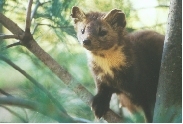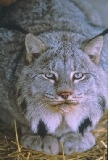 |
The purpose of this site is to inform and educate the public on the status, and recovery efforts concerning the Nova Scotia populations of American marten (Martes americana) and Canada lynx (Lynx canadensis). Much of the information presented here is aimed at the general public, those interested in the recovery of endangered species and those looking for wildlife conservation educational materials. More information on the American marten and Canada lynx will be available as the site matures and will include current status reports of these species, recovery and action plans, information targeting specific interest groups, pictures, distribution maps, recovery projects, downloadable files and links to other relevant sites. American marten  The
Cape Breton population of Marten is likely less than 50 animals. At
present there is no evidence of breeding and there has been extensive loss
and degradation of suitable habitat. Marten were trapped extensively
throughout Nova Scotia since the 1700's until the season was closed in the
early 1900's due to low numbers. The species was thought to have been
extirpated from the mainland and several re-introductions have been
attempted. There have been many very recent records of Marten in southwest
Nova Scotia. However, the status of the Marten on the mainland is
considered "data deficient." More research is required. The
Cape Breton population of Marten is likely less than 50 animals. At
present there is no evidence of breeding and there has been extensive loss
and degradation of suitable habitat. Marten were trapped extensively
throughout Nova Scotia since the 1700's until the season was closed in the
early 1900's due to low numbers. The species was thought to have been
extirpated from the mainland and several re-introductions have been
attempted. There have been many very recent records of Marten in southwest
Nova Scotia. However, the status of the Marten on the mainland is
considered "data deficient." More research is required.Resource Document: "How to Avoid Incidental Take Of American Marten While Trapping or Snaring Mink and other Furbearers." View PDF Document in English or French The purpose of this information contained in this document is to reduce injury and mortality to the Endangered American Marten population caused by trapping mink and/or other furbearers. Marten are similar in appearance and habits to mink, and their ranges overlap with other furbearer species, and with each other. Therefore, it is important for trappers to know how to distinguish marten from mink, to recognize their preferred habitat types, and to avoid capturing or harvesting marten. Trappers must also learn what to do if a marten is caught incidentally. NOTE: You will require Adobe Acrobat Reader to view. Download Adobe For Free Canada lynx |
|
Partial
funding for the projects and information on this site comes from the |
|
© NS DNR
2005 |
 Lynx
formally occurred in areas of suitable habitat across mainland Nova Scotia
and Cape Breton Island. The current population is very small and
restricted to two areas in the highlands of Cape Breton Island. Historic
and current threats to Lynx include: harvesting, competition from bobcats
and coyotes, habitat loss, disease and climate change.
Lynx
formally occurred in areas of suitable habitat across mainland Nova Scotia
and Cape Breton Island. The current population is very small and
restricted to two areas in the highlands of Cape Breton Island. Historic
and current threats to Lynx include: harvesting, competition from bobcats
and coyotes, habitat loss, disease and climate change.